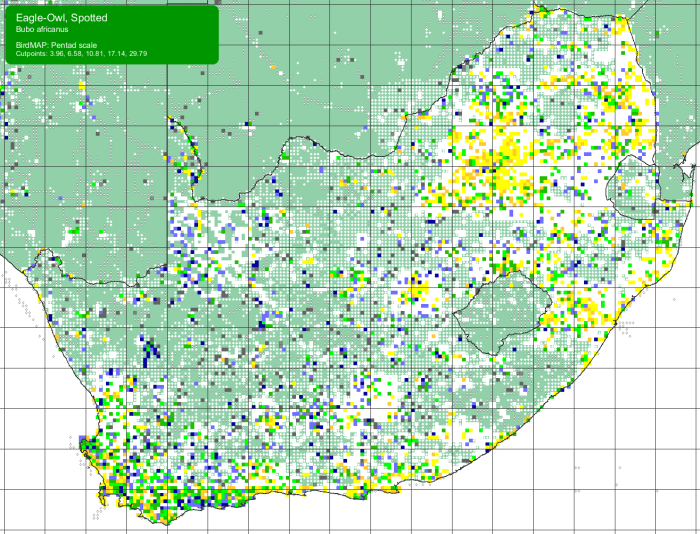Identification
The Spotted Eagle-Owl is a medium-sized, grey-brown owl with conspicuous ear-tufts and beautiful yellow eyes. The facial disk is off white to pale ochre in colour with a black outer edge. The upper body is dusky brown in colour with dark splotches on the breast while the lower parts are off-white with brown barring. Females and males are alike in colour and size.

The juvenile birds resemble the adults, but their ear tufts are less distinct and they often still have some visible fluffy down feathers.

The call of Spotted Eagle-Owls is a mellow hoot. The males usually give a double hoot, ‘hoo-hooooee’, which the female answers with a softer triple hoot, ‘hoo-hoo-hooee’. Owls call to find partners, to tell their partners where they are and to proclaim their territories.
The Spotted Eagle-Owl can be confused with the Cape Eagle-Owl Bubo capensis. In general, Cape Eagle-Owls are more rufous-brown in colour rather than grey and they have orange eyes rather than yellow, but this is not always so obvious. The surest way to tell the two apart is by looking at the patterning on the breast. The Spotted Eagle-Owl has fine barring and greyish-brown splotches, while the Cape Eagle-Owl has black and chestnut blotching.
Habitat
Spotted Eagle-Owls occur in various habitats including woodlands, savannas and grasslands, shrublands, semi-deserts and rocky hills. They have adapted to living with people and are found in towns and cities, as long as there are gardens and parks where they can hunt at night and roost, undisturbed, during the day. They nest on or in buildings, on window ledges, or in owl boxes provided by people, and use streetlights and telephone poles as perches.

Distribution
Spotted Eagle-Owls are one of the most common owl species in southern Africa. They are often seen in Kirstenbosch National Botanical Garden in Cape Town. Its range extends across sub-Equatorial Africa to southern Arabia.
Data from the second Southern African Bird Atlas Project (SABAP2) shows that the Spotted Eagle-Owl occurs right across South Africa. There are lots of gaps in this distribution map because the citizen scientists who do the fieldwork for the atlas project are active by day, whereas the Spotted Eagle-Owls are active at night!

Behaviour
The Spotted Eagle Owl is mostly active at night and before sunset. During the day it roosts in trees, or sheltered sites along cliff ledges, under bushes, abandoned buildings, or in burrows of other animals. When roosting in trees, it will usually sit close to the trunk with its feathers compressed, eyes closed, and ear-tufts erect. Breeding pairs will sometimes roost together, engaging in billing and allopreening.
They nest in many different places, most commonly on the ground, among rocks, under shrubs, in trees, tree hollows, cliff ledges, quarries, man-made structures, or eroded banks of a donga or river.

They mate for life and usually lay two to three white eggs at intervals of between one to four days. The female incubates the eggs, while the male provides food. Chicks hatch blind and begin to open their distinct yellow eyes after seven days. The young start leaving the nest and exploring at about four to six weeks. The parents continue to care for the young for a another five or six weeks after they fledge.
Spotted Eagle-Owls have a varied diet. What they eat depends a lot on their habitat and what is available. They hunt at dusk and at night. They prey on insects such as crickets and large beetles, small mammals such as shrews, mice, rats, and squirrels, and birds up to the size of a Laughing Dove. They will also hunt and eat amphibians and reptiles.

Further Resources
Species Text from the first Southern African Bird Atlas Project (SABAP1), 1997
Virtual Museum (BirdPix > Search VM > By Scientific or Common Name)
Other common names: Gevlekte Ooruil (Afrikaans); Isihulu-hulu (Xhosa); isiKhovampondo (Zulu); Grand-duc Africain (French); Afrikaanse Oehoe (Dutch).
A list of bird species in this format is available here.
Recommended citation format: Loftie-Eaton M, Damiel KA 2022. Spotted Eagle-Owl Bubo africanus. Bird Feeder Project. Biodiversity and Development Institute. Available online at https://thebdi.org/2022/03/29/spotted-eagle-owl-bubo-africanus/

